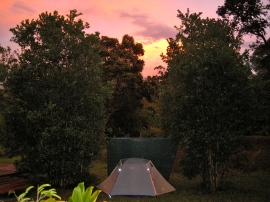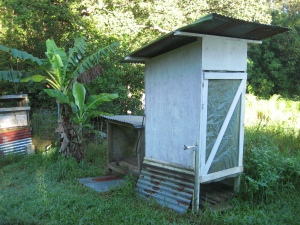Well, I’m at it again!

After loving 2 months in Kaua’i at Cloudwater Tea and 10 days in Taiwan – the queen of oolong tea – I now reside and WWOOF at Mauna Kea Tea Garden on the Big Island of Hawai’i. It’s much different here, in a very simple and also empowering way.
Mauna Kea Tea is up in the mountains of a small town called Honoka’a. The farm is 2000 feet above sea level and the clouds travel fast up here. I live at the base of the property in my tent. The tea evergreens here are smiling and beautiful; the farmer really knows his Camellia Sinensis and farming practices. While he does all of the tea processing himself, I get to learn about tea in its natural state from cutting to harvest. (I say “natural” as opposed to conventional or even organic. I explain further down). I’m not sure of the cultivars, but there are both the China and India bush varieties. You can always visit Mauna Kea’s website for more information on their final product.
There is a communal cabin for cooking and lounging. We have a propane-powered outdoor shower and cooking elements. The outhouse is a squatter, electricity is solar supplied, and there is no fridge or any major appliances. The lifestyle here is simple and humbling with basic foods and cooking ware supplied. I’ve suggested that the general theme here is, the less you have in life, the more forced you are to live. And here I am, forcing myself to live; otherwise, I don’t have the self-discipline to live under such conditions. I’m learning to cook with simple ingredients, tenting on a rainy mountainside, practicing the way of Natural Farming, and all done in the presence of tea. This (almost semi-primitive) lifestyle is simple, healthy, sustainable. While it might seem limited at first, they farmers here are actually providing us with an environment in which we can experiment and learn through experience. Instead of just giving us all of the answers and “necessities” we get to figure them out on our own and work with what we’ve got – it’s a very empowering environment if you choose to look at it in that way. Plus, they don’t just talk about sustainability here, they apply it with their farming and daily living practices.
I might add, just as a reminder, when I refer to tea, I usually mean tea as a beverage, an art, a culture, a history, a medicine, a metaphor; tea is an act of service, a welcoming… you get the point.
Back to the farm; uniformly scattered throughout the property and tea beds, old and ominous Ohia trees grow. Reaching out like shadowy hands against brick walls in a back-alley, their rough twisting branches offer dark and silvery shades of green leaves. Walking amongst the Ohia at night might cause an ominous internal stir, however, these aged giants are more like sages and guardians of the tea gardens. Bringers of shade and buffers of wind; their beauty is rustic, crude, weathered, and strong.
NATURAL FARMING
Upon coming here and reflecting on the direction of my tea influenced travels, it’s boiled down to this: I’ve gone from drinking tea, to farming and processing tea, to where things stand now; strictly farming with tea. Originally, I wanted to go back to roots of tea – that being the farm. Now, as I’ve come to the farm, I am lead towards the roots of farming, that being Natural Farming, which follows a path (or pathless path to be correct) as closely aligned with nature as possible. This is roughly the model of farming at Mauna Kea, which in turn becomes the model for growing tea, their mono-agricultural product. What is Natural Farming? Strictly speaking, hunting and gathering is the essence of Natural Farming, but for agriculture purposes, it means no chemicals or prepared compost, no cultivation (plowing or turning the soil), no weeding by tillage or herbicides, and no dependence on chemicals.
“The ultimate goal of Natural Farming is not the growing of crops, but the cultivation and perfection of human beings.” In one sense, it is a pursuing of the way of nature, but in a broader sense, it is a spontaneous communion between humans and nature that arises naturally of itself – something that cannot be pursued. When we let go of human will and allow nature to guide us, nature in turn takes care of everything.
That’s the funny thing: it turns out that when you let nature take its natural course, all is well. “Nature is never in a hurry, yet accomplishes everything.” All of the so-called necessary farming practices are only necessary because we’ve created a system in which agricultural products are dependent upon them. When pests come, we use pesticide, and then our plants depend on the increased use of pesticides – a weaker plant (deviated from the norm) now exists and we think we’ve fixed the problem… If you let insects come, their natural predators will also come, and equilibrium will be established with time. Conventional farming is dependent on unhealthy and useless farming practices because that’s the system that has been created and perpetuated. That being said, there are no standardized methods to Natural Farming; it must be adapted and implemented accordingly based on your geographical location.
I suppose I could paraphrase the entire book, but if you’re really interested, you should read The One-Straw Revolution by Masanobu Fukuoka. He goes against everything we thought we knew (in agriculture) in an attempt to show us we don’t know anything (in general) through the medium of farming. Natural Farming is sustainable, organic, simple, (enjoyable!), and follows the path of nature.
Pictures to come!…
TLC















































